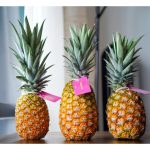1. The Problem: Durian Fruitlet Drop
Durian naturally experiences heavy fruitlet drop in 2–3 waves:
- First drop (7–14 days after pollination): Poor fertilization, weak embryos, or nutrient stress.
- Second drop (3–5 weeks after pollination): Hormonal imbalance, carbohydrate shortage, or water stress.
- Third drop (after 6–8 weeks): Physiological adjustment — tree sheds excess fruits to balance canopy and energy reserves.
Fruitlet retention at harvest can be as low as 1–2% of total flowers without intervention.
2. Role of Biostimulants & Hormones
Durian fruitlet retention depends heavily on hormonal balance — mainly auxin, gibberellin, cytokinin, and ethylene. Biostimulants or hormone applications can improve this balance under stress or nutrient limitations.
A. Auxin (IAA / NAA / 4-CPA)
- Function: Prevents abscission (fruit drop) by maintaining the connection between fruit and stem.
- Application: Foliar spray 10–15 ppm NAA or 10–20 ppm 4-CPA around 10–14 days after fruit set. Repeat after 2–3 weeks.
- Effectiveness: Can reduce fruitlet drop by 20–40%, depending on cultivar and stress conditions.
- Caveat: Overdose (>30 ppm) can cause fruit deformities or excessive vegetative growth.
B. Cytokinins (e.g., Kinetin, CPPU, 6-BA)
- Function: Promotes cell division and sink strength of young fruitlets, delaying senescence and drop.
- Application: Low rate foliar spray (5–10 ppm 6-BA) during early fruit development stage.
- Effectiveness: Improves fruit size uniformity and reduces mid-stage drop by 15–30%.
- Often used in combination with auxins for best results.
C. Gibberellins (GA₃)
- Function: Enhances fruit elongation and carbohydrate mobilization; delays abscission.
- Application: 20–50 ppm foliar GA₃ 10 days after fruit set.
- Effectiveness: 10–25% reduction in drop; useful when carbohydrate supply is low (e.g., cloudy season).
- But high GA₃ can interfere with flower initiation in the next season.
D. Ethylene Inhibitors (e.g., AVG or Silver Thiosulfate)
- Function: Suppresses ethylene production that triggers fruit abscission.
- Effectiveness: Promising in trials, but rarely used commercially in durian due to cost and regulation.
E. Biostimulants (Non-hormonal)
These improve physiological resilience, indirectly reducing fruitlet drop:
| Type | Function | Example | Effectiveness |
| Seaweed extracts | Natural cytokinins + betaines to enhance stress tolerance | Ascophyllum nodosum | 10–20% reduction |
| Amino acid complexes | Improves nutrient uptake, reduces stress | Glycine-based foliar | 10–15% |
| Humic/fulvic acids | Improves root nutrient absorption | Potassium humate | Indirect but helps root vigor |
| Silicon formulations | Strengthens vascular tissues, reduces abscission stress | Silicate sprays | 5–10% |
| Microbial inoculants (PGPR, Trichoderma) | Enhances root hormone signaling & nutrient availability | Bacillus spp., Pseudomonas spp. | 10–25% long-term benefit |
⚗️ 3. Integrated Field Strategy (Commercial Durian Practice)
A practical combination (used in Thailand and Malaysia):
| Stage | Application | Function |
| Flowering (pre-pollination) | Seaweed extract + amino acid | Improve flower set |
| 1 week after fruit set | NAA 10 ppm + GA₃ 20 ppm | Prevent first wave drop |
| 3 weeks after fruit set | 6-BA (cytokinin) + micronutrients (B, Zn) | Maintain fruit growth |
| 5–6 weeks after fruit set | Seaweed + calcium-boron | Strengthen fruit stem and skin |
| 10 weeks onward | Controlled irrigation + potassium-based fertilizer | Prevent physiological drop |
This integrated program can improve fruit retention by 30–50%, depending on cultivar and environmental control.
4. Limitations & Considerations
- Hormones cannot override carbohydrate shortage. If the tree lacks energy (due to heavy crop load or cloudy weather), fruit drop still happens.
- Dosage & timing are crucial — small errors can cause deformation or delayed ripening.
- Tree age and health determine responsiveness. Mature, balanced trees respond better than young overfertilized ones.
- Regulatory caution: Some synthetic hormones may not be approved for commercial use in every country.
5. Key Takeaway
Biostimulants and hormones can reduce small durian fruitlet drop by 20–50%, but only when used as part of a balanced nutrient and water management program.
The best results come from combined low-dose hormone sprays (auxin + cytokinin + GA) with biostimulants that maintain root health and carbohydrate flow.
Source: Professional Platform
Note: For Reference Only










